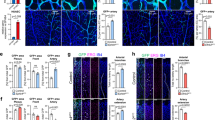Abstract
Various cellular signaling pathways play essential roles in regulating embryonic vascular development. Among them, Notch signaling is implicated in arterial endothelium differentiation and vascular morphogenesis. Mice that lack Notch receptors or other signaling components die in utero due to severe vascular abnormalities. We previously identified the Hairy-related transcription (Hrt) factor family, also called Hey, Hesr, CHF, Herp, and Gridlock, as downstream mediators of Notch signaling in the developing vasculature [1]. The Hrt family proteins, Hrt1/Hey1, Hrt2/Hey2, and Hrt3/HeyL, mainly act as transcriptional repressors, by binding to consensus DNA elements or by associating with other DNA-binding transcription factors. The mice deficient for Hrt2 showed perinatal lethality due to ventricular septal defects and mitral valve insufficiency, and cardiomyocyte-specific deletion of Hrt2 caused abnormal expression of atrial-specific genes in the ventricle and cardiac dysfunction in adulthood [2].
You have full access to this open access chapter, Download chapter PDF
Similar content being viewed by others
Keywords
Various cellular signaling pathways play essential roles in regulating embryonic vascular development. Among them, Notch signaling is implicated in arterial endothelium differentiation and vascular morphogenesis. Mice that lack Notch receptors or other signaling components die in utero due to severe vascular abnormalities. We previously identified the Hairy-related transcription (Hrt) factor family, also called Hey, Hesr, CHF, Herp, and Gridlock, as downstream mediators of Notch signaling in the developing vasculature [1]. The Hrt family proteins, Hrt1/Hey1, Hrt2/Hey2, and Hrt3/HeyL, mainly act as transcriptional repressors, by binding to consensus DNA elements or by associating with other DNA-binding transcription factors. The mice deficient for Hrt2 showed perinatal lethality due to ventricular septal defects and mitral valve insufficiency, and cardiomyocyte-specific deletion of Hrt2 caused abnormal expression of atrial-specific genes in the ventricle and cardiac dysfunction in adulthood [2].
It was also reported that combined loss of Hrt1 and Hrt2 resulted in early embryonic lethality due to vascular demise similar to that observed in Notch signal-deficient embryos. While Hrt1 and Hrt2 are expressed in endothelial cells as well as smooth muscle cells of embryonic vasculature, it remained unclear which vascular cell type requires Hrt1/Hrt2 functions. In the present study, we generated the mice with endothelial-cell-specific deletion of Hrt2 combined with global Hrt1 null mutation and analyzed their vascular phenotypes during embryonic development. The loss of endothelial Hrt1/Hrt2 caused early vascular abnormalities virtually identical to those observed in the global Hrt1/Hrt2 knockout mouse embryos (Fig. 31.1), suggesting that Hrt functions in endothelial cells are indispensable for normal vascular development.
The mice in which Hrt2 was deleted specifically in endothelial cells with the global Hrt1 null background (H1ko/H2eko) show embryonic lethality with severe defects of vascular morphogenesis. Whole mount PECAM1 immunostaining demonstrated impairment of vascular network formation in H1ko/H2eko embryos
References
Nakagawa O, Nakagawa M, Richardson JA, Olson EN, Srivastava D. Hrt1, Hrt2, and Hrt3: a new subclass of bHLH transcription factors marking specific cardiac, somitic, and pharyngeal arch segments. Dev Biol. 1999;216:72–84.
Xin M, Small EM, van Rooij E, Qi X, Richardson JA, Srivastava D, Nakagawa O, Olson EN. Essential roles of the bHLH transcription factor Hrt2 in repression of atrial gene expression and maintenance of postnatal cardiac function. Proc Natl Acad Sci U S A. 2007;104:7975–80.
Author information
Authors and Affiliations
Corresponding author
Editor information
Editors and Affiliations
Rights and permissions
Open Access This chapter is distributed under the terms of the Creative Commons Attribution-Noncommercial 2.5 License (http://creativecommons.org/licenses/by-nc/2.5/), which permits any noncommercial use, distribution, and reproduction in any medium, provided the original author(s) and source are credited. The images or other third party material in this chapter are included in the work's Creative Commons license, unless indicated otherwise in the credit line; if such material is not included in the work's Creative Commons license and the respective action is not permitted by statutory regulation, users will need to obtain permission from the license holder to duplicate, adapt or reproduce the material.
Copyright information
© 2016 The Author(s)
About this chapter
Cite this chapter
Sakabe, M., Morioka, T., Kimura, H., Nakagawa, O. (2016). Roles of Endothelial Hrt Genes for Vascular Development. In: Nakanishi, T., Markwald, R., Baldwin, H., Keller, B., Srivastava, D., Yamagishi, H. (eds) Etiology and Morphogenesis of Congenital Heart Disease. Springer, Tokyo. https://doi.org/10.1007/978-4-431-54628-3_31
Download citation
DOI: https://doi.org/10.1007/978-4-431-54628-3_31
Published:
Publisher Name: Springer, Tokyo
Print ISBN: 978-4-431-54627-6
Online ISBN: 978-4-431-54628-3
eBook Packages: MedicineMedicine (R0)





